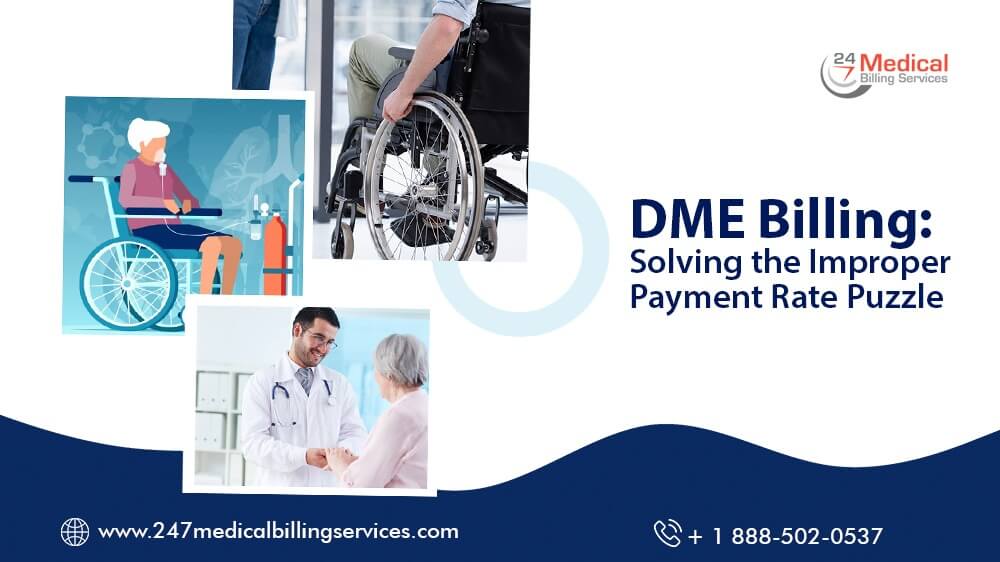
DME Billing: Solving the Improper Payment Rate Puzzle
According to recent CERT data, the DME billing space has a 39.9% improper payment rate, draining $3.2 billion from the Medicare Trust Fund each year. This error rate is three times higher than the current national Medicare wrong payment rate of 12.1%.
What is the simplest way to avoid this industry’s baggage and ensure you receive maximum reimbursements every time?
Providing clean paperwork and documentation is critical to avoid mistakes and reduce improper payment. To ensure error-free submissions, the medical billing team must avoid common causes of improper payments, such as inadequate documentation, insufficient documentation (required to make informed decisions), or incorrect coding. Examine the following practical methods for lowering improper payment rates in DME billing.
Ensure Complete Documentation
Documentation is essential for accurate DME billing; good documentation is strategic. A detailed narrative is provided by accurate and complete patient documentation and using correct modifiers. Documentation at each stage leads to accurate and timely reimbursement. Documentation assists payers in determining whether or not the billed services were actually provided, at the level billed, and/or were medically necessary.
In its 2019 Medicare Fee-for-service Supplemental Improper Payment Data report, the U.S. The Department of Health and Human Services highlighted the top root causes of insufficient documentation errors in DMEPOS.
Avoid Documentation Errors
Simple errors can result in claim rejection or denial. As a result, reducing the likelihood of insufficient documentation errors is critical. Here are some handy tips to be followed to avoid documentation errors:
- To be reimbursed, ensure that your in-house staff, such as the nurse, medical assistant, or the doctor himself, evidently records and documents a face-to-face encounter evaluation with the patient within the previous six months before placing an order for specific DME equipment.
- To receive DME reimbursements, ensure that the ordering physician and DME supplier are enrolled in Medicare on the service date.
- Confirm if the doctor's National Provider Identifier is listed on the valid detailed written order.
- Analyze and comprehend which HCPCS codes related to DME necessitate a valid detailed written order.
Ascertaining Medical Necessity
To establish medical necessity, you must submit a lengthy paper trait that strongly supports the DME's medical necessity. Submit any necessary documentation that certifies the medical necessity and helps to reflect the patient's condition accurately. Critical medical records and documents aid in making an informed decision that the services billed were medically necessary for accordance with Medicare coverage and payment policies. This includes the clinical documentation, provider's prescription, and other information such as:
- The patient's medical history
- Detailed clinical and functional status of the member so that medical necessity can be determined
- Benefits and outcomes expected from using the DME
- Treatment plan devised by a licensed provider
Analyze and Improvise
Streamlining your DME billing process will not improve collection rates or cash flow. Constant work and regular audits by a team of experts are required for effective revenue cycle management. Analysis and deep insight into the alteration to address and items to eliminate are critical components of the process. This improves cash flow and optimizes your revenue cycle for the success of your DME.
24/7 Medical Billing Services - Improper Payment Rate Solution!
Attempting to take a few simple steps to streamline your DME billing process can significantly improve collections and revenue. On the other hand, creating a game plan and putting it into action are two entirely different things. Remember to gather as a team, discuss how it will be carried out, and then revisit and review your progress regularly to determine what needs to be fixed. This has the potential to be a game-changer!
Outsourcing a portion of DME medical billing, such as insurance verification and charge entry, makes sense for some hospital providers. 24/7 Medical Billing Services works with DME and HME practices to identify and implement streamlined and optimized medical billing processes.

.png)